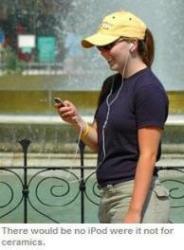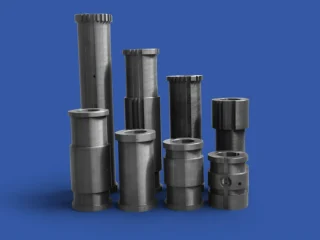Ceramics Make Electronic Devices Possible
The nearly $2-trillion global electronics industry would not exist without ceramics. Ceramics’ wide range of electrical properties including insulating, semi-conducting, superconducting, piezoelectric and magnetic are critical to products such as cell phones, computers, television, and other consumer electronic products. The global market for electronic ceramics is estimated at around $9 billion.
Ceramic spark plugs, which are electrical insulators, have had a large impact on society. They were first invented in 1860 to ignite fuel for internal combustion engines and are still being used for this purpose today. Applications include automobiles, boat engines, lawnmowers, and the like. High voltage insulators make it possible to safely carry electricity to houses and businesses.
Save the Date!
ACerS Electronics and Basic Science division will host Electronic Materials and Applications 2013
in Orlando, Fla. January 23 – 25, 2013. EMA 2013 will focus on focuses on
electronic materials for energy generation, conversion and storage applications.
Ceramics Improve Antenna Performance
The next generation of mobile phone antennas would not be possible without special ceramics developed by Morgan Advanced Ceramics for Sarantel, a leading miniature antenna specialist. Sarantel’s PowerHelix range uses a patented design in which copper tracks, deposited onto a small ceramic cylinder, are individually and automatically laser trimmed for optimum frequency response.
Currently, this type of antenna is used in GPS applications, where its zero ground plane allows space saving in handheld and portable equipment. When mounted side by side, the antennas can also be used in combined applications such as Bluetooth and GPS without loss of performance. However, it is within the mobile phone market that the PowerHelix range may be of most benefit. Under E-911 Legislation in the United States, it will soon be mandatory for GPS receivers to be built in to mobile phone handsets, so that the technology can be used to help emergency services respond more effectively to distress calls. 3G mobile and Wi-Fi networks are also potential applications.
The continuing debate over the health implications of using mobile phones is another major issue. International safety regulations defined in terms of the specific energy absorption rate (SAR) encourage optimization of the ratio of radiated power versus absorbed power in the user head. The patented PowerHelix antenna design significantly reduces the losses of current that can cause an incident magnetic field at the user’s skin. A specific ceramic is used that enables the manufacture of antennas which yield just five per cent of the radiation emitted by other systems.
Transistors Advance With Ceramic Material
Intel is combining new high dielectric ceramic and metal materials to build the insulating walls and switching gates of its 45 nanometer transistors. Transistors are tiny switches that process the ones and zeroes of the digital world. The gate turns the transistor on and off and the gate dielectric is an insulator underneath it that separates it from the channel where current flows.
Hundreds of millions of these microscopic transistors-or switches-will be inside the next generation of multi-core processors, resulting in record-breaking PC, laptop and server processor speeds. By replacing the conventional dielectric material with a thicker hafnium-based oxide material, transistor gate leakage is reduced by more than 10 times and transistors can be made smaller, increasing transistor density by approximately two times.
When the hafnium ceramic is combined with a compatible metal gate, the result is more than a 20 percent increase in drive current (higher transistor performance) and more than a five times reduction in source-drain leakage, thus improving the energy efficiency of the transistor. The smaller transistor size means active switching power is reduced by approximately 30 percent.
More: www.ceramics.org







 Enquiry
Enquiry